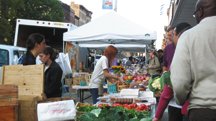The approaching fall chill brings with it the end of farmer’s market season – in cities afar and right here in Hoboken.
The downtown and uptown Hoboken Farmers’ Markets each closed out their 2010 season last week, also bringing an end to fresh, locally-grown produce for hundreds of hungry people who rely on the Hoboken Shelter for food each day.
For the first time in their long histories, these two Mile Square institutions developed a formal relationship with one another this year that enabled farmers to donate unsold food to the shelter and allowed the shelter to offer more nutritious meals.
“Every day, our guests would pass up a donut for a banana.” – Jaclyn Cherubini
________
300 meals a day
As with many grassroots undertakings, the relationship forged between the farmers’ market and the shelter came about because concerned residents saw a problem, a solution, and decided to fit a round peg in a round hole.
“A couple of community members were generous in thinking about how the farmers market could benefit the shelter,” said Jaclyn Cherubini, executive director of the Hoboken Shelter. “This was a brilliant idea because fresh produce is wonderful to cook with and our guests really truly enjoy eating good food. It was wonderful for us because it was plentiful and generous and made our meals even more nutritious. Every day, our guests would pass up a donut for a banana.”
Among those instrumental in getting market produce to the shelter was Hoboken firefighter Rich Marsh, who’s also president of the Hoboken Rotary Club.
Donations from the markets – which operated on Tuesdays and Thursdays – were different each day, Cherubini said, and ranged anywhere from kale to corn, broccoli to tomatoes.
The shelter currently serves 300 total meals a day, a number that Cherubini said has doubled “in the last handful of years. We used to serve only 150 meals a day…We average about 100 meals every night [for dinner]. Half of those who come are shelter guests (residents of the shelter); a quarter of whom are the street-dwelling homeless; and a quarter of whom are the working poor, and that’s the number that’s growing more and more each day.”
The working poor who come to the shelter are people with jobs, but who earn too little to feed themselves each day between paychecks, and who use meals from the shelter to help them make it to their next paycheck.
The shelter offers two seatings for breakfast, two seatings for lunch, and one dinner meal each day for anyone who is hungry and wants a meal. There are no income requirements to eat a meal.
Because the homeless and the cash-strapped tend to eat meals that are cheap and filling, but not terribly nutritious, the shelter, Cherubini said, tries to keep its meals healthy, well-rounded, and consistent with the food pyramid.
‘I’d rather see someone have it’
Jersey farmers who donated to the shelter this summer were glad their bounties weren’t wasted.
“You always have stuff that’s not saleable, that nobody will purchase,” said Carol Davis of Stony Hill Gardens, based in Chester. “You know, peppers that have a spot on them. A tomato that has a crack in it. Apples that have a little bruise on them. But those things are still very edible. They can still be made into something, it’s still good food that people can eat. So, we look for ways to get it to people that need it.”
Food that isn’t sold at farmers’ markets, Davis noted, would normally be fed to her animals back on the farm, a practice that’s typical on most farms.
Josh Drake of Long Valley’s Ort Farm said he would also give leftover food to his cows. But, “the market managers came around and said, ‘The food shelter is coming. Would you be willing to give some of the stuff that’s leftover to the shelter?’”
Drake, who was new to the Hoboken Farmers’ Market this year, agreed.
“I usually always give corn, ‘cause it’s picked fresh in the morning,” he added. “We usually don’t sell it all. So, I usually give that to them, and tomatoes…I have other food I can feed to my cows and other animals. I’d rather see someone have it.”
Filling the gap this winter
With the market season now over, Cherubini said the shelter will now rely on donations from the local community to fill the void.
“The community has always been very generous to the shelter,” she said. “The United Synagogue of Hoboken gives regularly each week. And we have a lot of community members and companies that host dinner for our guests.”
The estimated cost to host a dinner for 100 people is about $300, she said.
And proving that no donation is too small, Cherubini said that what the shelter really needs are paper plates, napkins, and plastic utensils.
“It only costs us $2 to serve a meal, and most of that cost is for plates and forks. Every little bit helps,” Cherubini said. “I can’t stress that enough. Every little bit truly does help.”
To donate to the Hoboken Shelter, call (201) 656-5069.
E-mail E. Assata Wright at awright@hudsonreporter.com.
